“Blue carbon” or coastal habitats may sequester significantly more carbon dioxide than forests.
Coastal wetlands have long been recognized for their wildlife values, their vital role in water quality, and their significance in protecting our built environmental during storm events. Scientists, however, have recently begun to document another critically important value: their ability to absorb atmospheric carbon and help mitigate climate change.
A recent assessment of all coastal habitats in Tampa Bay shows that marshes, mangroves and seagrasses can remove more than 3.8 million metric tons of carbon dioxide from the atmosphere over the next 100 years – equal to taking 7,981 passenger cars off the road every year until 2100. In addition to the protection of existing coastal habitats, restoration projects also played an important role in the assessment. Beyond their other benefits, habitats restored since 2006 will account for the storage of 240,000 metric tons of carbon dioxide which is the equivalent of removing the emissions of 45,800 vehicles by 2100.
“Blue carbon” refers to the ability of tidal wetlands and seagrass habitats to store or release carbon and other greenhouse gases. According to the National Oceanic and Atmospheric Administration (NOAA), mangrove forests and coastal wetlands may be able to store up to five times more carbon than a tropical forest of equal size. Unlike forests, coastal wetlands store carbon mainly in soils (rather than in foliage or limbs). It can remain locked in soils for centuries or more. When these ecosystems are drained or degraded, the stored carbon can be rapidly released back into the atmosphere – sometimes releasing centuries worth of stored carbon in only a few decades.
The study also assessed how sea-level rise will impact these habitats. It provides several recommendations to help managers prepare for and address changes in coastal regions including:
- Improving tidal wetland resilience, specifically enabling habitats to build up and keep pace with sea level rise which also provides other ecosystem benefits such as protecting inland properties, improving water quality and creating nursery habitat for key fish species
- Conserving upland areas to allow coastal habitat migration to occur in response to rising seas
- Prioritizing vulnerable areas for restoration and/or acquisition, such as areas that are already more susceptible to flooding, and
- Maintaining (or improving where necessary) water quality to allow seagrass expansion to occur in in newly flooded coastal lands where marshes and mangroves are unable to persist in the future
“Over the past two decades, the Tampa Bay community has made great progress in improving the health of Tampa Bay’s waters,” said Holly Greening, executive director of the Tampa Bay Estuary Program. “We want to ensure that progress will not be lost as a result of sea level rise. The data and model provided by this study will help us chart a course forward that protects the work that our public and private sector partners have collectively accomplished over the past 45 years.”
This report was a collaborative effort of Restore America’s Estuaries, Environmental Science Associates, Tampa Bay Estuary Program, Tampa Bay Watch, U.S. Geological Society, Woods Hole Oceanographic Institute, and the Florida Fish and Wildlife Institute. Funding was provided by the Tampa Bay Environmental Restoration Fund, NOAA’s Office of Habitat Conservation, U.S. Environmental Protection Agency, U.S. Fish and Wildlife Service – Coastal Program, and Scott’s Miracle-Gro.
For more information on the study, visit http://baysoundings.com/could-blue-carbon-change-the-tide/ or read the full report at https://www.estuaries.org/bluecarbon-resources
